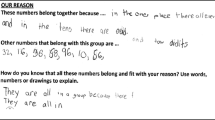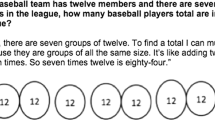Abstract
Engaging students in comparing and contrasting, forming conjectures, generalising and justifying is critical to develop their mathematical reasoning, but there are untapped opportunities for primary school students to improve these reasoning processes in mathematics lessons. Through a case study of one task, this paper reports on levels of justifying and the connections to other reasoning processes of comparing and contrasting, forming conjectures and generalising observed among Year 3–4 Australian and Canadian students (9–10-year olds) using the mathematical reasoning actions and levels (MRAL) framework (Authors 2017). The findings revealed that examining commonalities and differences was critical to allow Year 3–4 students to form conjectures and generalise for themselves. Justifying by examples and seeking counterexamples to evaluate the conjecture were prevalent with some students attempting to develop logical argument. The findings have implications for frameworks that assess students’ levels of justifying and for teacher actions that encourage students to communicate their reasoning through oral and non-verbal as well as written communications.






Similar content being viewed by others
References
Australian Curriculum, Assessment and Reporting Authority (ACARA) (2018). Australian Curriculum: Mathematics. Retrieved from https://www.australiancurriculum.edu.au/f-10-curriculum/mathematics.
Authors (2015)
Authors (2017)
Cañadas, M. C., Deulofeu, J., Figueiras, L., Reid, D., & Yevdokimov, O. (2007). The conjecturing process: Perspectives in theory and implications for practice. Journal of Teaching and Learning, 5(1), 55–72.
Carpenter, T. P., Franke, M. L., & Levi, L. (2003). Thinking mathematically: Integrating arithmetic & algebra in elementary school. Portsmouth: Heinemann.
Chen, C.-L., & Herbst, P. (2013). The interplay among gestures, discourse, and diagrams in students’ geometrical reasoning. Educational Studies in Mathematics., 83(2), 285–307.
Cooper, T., & Warren, E. (2008). The effect of different representations on years 3 to 5 students’ ability to generalise. ZDM Mathematics Education., 40(1), 23–37.
El Mouhayar, R. (2018). Trends of progression of student level of reasoning and generalization in numerical and figural reasoning approaches in pattern generalization. Educational Studies in Mathematics., 99(1), 89–107. https://doi.org/10.1007/s10649-018-9821-8.
Ellis, A. B. (2007a). Connections between generalizing and justifying: Students’ reasoning with linear relationships. Journal for Research in Mathematics Education, 38(3), 194–229.
Ellis, A. B. (2007b). A taxonomy for categorizing generalizations: Generalizing actions and reflection generalizations. Journal of the Learning Sciences, 16(2), 262–269.
Fujii, T., & Stephens, M. (2001). Fostering an understanding of algebraic generalization through numerical expressions: The role of quasi-variables. In H. Chick, K. Stacey, J. Vincent, & J. Vincent (Eds.), Proceedings of the 12th ICMI study conference: The future of the teaching and learning of algebra (pp. 258–264). Melbourne: University of Melbourne.
Gibbons, P. (2015). Scaffolding language, scaffolding learning (2nd ed.). Portsmouth, NH: Heinemann.
Glaser, B. G. (1965). The Constant Comparative Method of Qualitative Analysis. Social Problems, 12(4, Spring 1965), 436–445. https://doi.org/10.2307/798843.
Goldenberg, P., & Mason, J. (2008). Shedding light on and with example spaces. Educational Studies in Mathematics., 69(2), 183–194.
Hanna, G. (1990). Some pedagogical aspects of proof. Interchange, 21(1), 6–13.
Harel, G., & Sowder, L. (1998). Students’ proof schemes. In E. Dubinsky, A. Schoenfeld, & J. Kaput (Eds.), Research on collegiate mathematics education (Vol. III, pp. 234–283). Providence, RI: American Mathematical Society.
Harel, G., & Sowder, L. (2007). Toward comprehensive perspectives on the learning and teaching of proof. In F. K. Lester Jr. (Ed.), Second handbook of research on mathematics teaching and learning (pp. 805–842). Greenwich, CT: Information Ag.
Hunter, J. (2014). Developing learning environments which support early algebraic reasoning: A case from a New Zealand primary classroom. Mathematics Education Research Journal, 26(4), 659–682.
Jeannotte, D., & Kieran, C. (2017). A conceptual model of mathematical reasoning for school mathematics. Educational Studies in Mathematics., 96(1), 1–16.
Knuth, E. J. (2002). Teachers’ conceptions of proof in the context of secondary school mathematics. Journal of Mathematics Teacher Education, 5(1), 61–88.
Knuth, E., Zaslavsky, O., & Ellis, A. (2019). The role and use of examples in learning to prove. Journal of Mathematical Behavior, 53, 256–262. https://doi.org/10.1016/j.jmathb.2017.06.002.
Komatsu, K. (2010). Counter-examples for refinement of conjectures and proofs in primary school mathematics. The Journal of Mathematical Behavior., 29(1), 1–10.
Lannin, J. K. (2005). Generalization and justification: The challenge of introducing algebraic reasoning through patterning activities. Mathematical Thinking and Learning, 7(3), 231–258.
Lannin, J., Ellis, A., & Elliott, R. (2011). Developing essential understanding of mathematical reasoning for teaching mathematics in prekindergarten—grade 8. Reston, VA: National Council of Teachers of Mathematics.
Lin, P.-J., & Tsai, W.-H. (2016). Enhancing students’ mathematical conjecturing and justification in third-grade classrooms: The sum of even/odd numbers. Journal of Mathematics Education, 9(1), 1–15.
Lin, F.-L., Yang, K.-L., Lee, K.-H., Tabach, M., & Stylianides, G. J. (2012). Principles of task design for conjecturing and proving In G, Hanna & M. de Villiers (Eds.), Proof and proving in mathematics education (pp. 305–325). New York: NY Springer.
Lo, M. P. (2012). Variation theory and the improvement of teaching and learning. Goteborg, Sweden: Acta Universitatis Gothoburgensis.
Lobato, J. (2003). How design experiments can inform a rethinking of transfer and vice versa. Educational Researcher, 32(1), 17–20.
Lobato, J., Hohensee, C., & Rhodehamel, B. (2013). Students’ mathematical noticing. Journal for Research in Mathematics Education, 44(5), 809–850.
Maher, C., & Martino, A. M. (1996). The development of the idea of mathematical proof: A 5-year case study. Journal for Research in Mathematics Education, 27(2), 194–214.
Mason, J. (1982). Thinking mathematically. London: Addison- Wesley.
Mata-Pereira, J., & da Ponte, J. P. (2017). Enhancing students’ mathematical reasoning in the classroom: teacher actions facilitating generalization and justification. Educational Studies in Mathematics, 96(2), 169–186.
Pedemonte, B. (2007). How can the relationship between argumentation and proof be analysed? Educational Studies in Mathematics, 66(1), 23–41.
Reid, D. (2002). Conjectures and refutations in grade 5 mathematics. Journal for Research in Mathematics Education, 33(1), 5–29.
Stacey, K. (2010). Mathematics teaching and learning to reach beyond the basics. In C. Glascodine & K.-A. Hoad (Eds.), Teaching mathematics? Make it count: What research tells us about effective mathematics teaching and learning (pp. 17–20). Camberwell, VIC: ACER.
Staples, M. E., Bartlo, J., & Thanheiser, E. (2012). Justification as a teaching and learning practice: Its (potential) multifaceted role in middle grades mathematics classrooms. Journal of Mathematical Behavior, 31, 447–462.
Strauss, A. L., & Corbin, J. (1998). Basics of qualitative research: Techniques and procedures for developing grounded theory. Thousand Oaks: SAGE Publications.
Stylianides, A. J. (2007). The notion of proof in the context of elementary school mathematics. Educational Studies in Mathematics, 65(1), 1–20.
Stylianides, G. J., & Stylianides, A. J. (2009). Facilitating the transition from empirical arguments to proof. Journal for Research in Mathematics Education, 40(3), 314–352.
Swan, M. (2011). Improving reasoning: analysing alternative approaches. Retrieved from http://nrich.maths.org/7812/index.
University of Cambridge. (2018). Magic Vs. Retrieved from https://nrich.maths.org/6274
Wood, M. B. (2016). Rituals and right answers: Barriers and supports to autonomous activity. Educational Studies in Mathematics, 91, 327–348.
Yackel, E., & Hanna, G. (2003). Reasoning and proof. In J. Kilpatrick, W. G. Martin, & D. Schifter (Eds.), A research companion to principles and standards for school mathematics (pp. 227–236). Reston: NCTM.
Yankelewitz, D., Mueller, M., & Maher, C. (2010). A task that elicits reasoning: a dual analysis. The Journal of Mathematical Behavior, 29(2), 76–85.
Yin, R. (2014). Case study research: design and methods (5th ed.). Thousand Oaks, CA: Sage.
Acknowledgements
This project was funded by the Faculty of Arts and Education Research Grant, Deakin University. The project team gratefully acknowledge the contributions of participating teachers, students and schools.
Author information
Authors and Affiliations
Corresponding author
Additional information
Publisher’s note
Springer Nature remains neutral with regard to jurisdictional claims in published maps and institutional affiliations.
Rights and permissions
About this article
Cite this article
Widjaja, W., Vale, C., Herbert, S. et al. Linking comparing and contrasting, generalising and justifying: a case study of primary students’ levels of justifying. Math Ed Res J 33, 321–343 (2021). https://doi.org/10.1007/s13394-019-00306-w
Received:
Revised:
Accepted:
Published:
Issue Date:
DOI: https://doi.org/10.1007/s13394-019-00306-w




